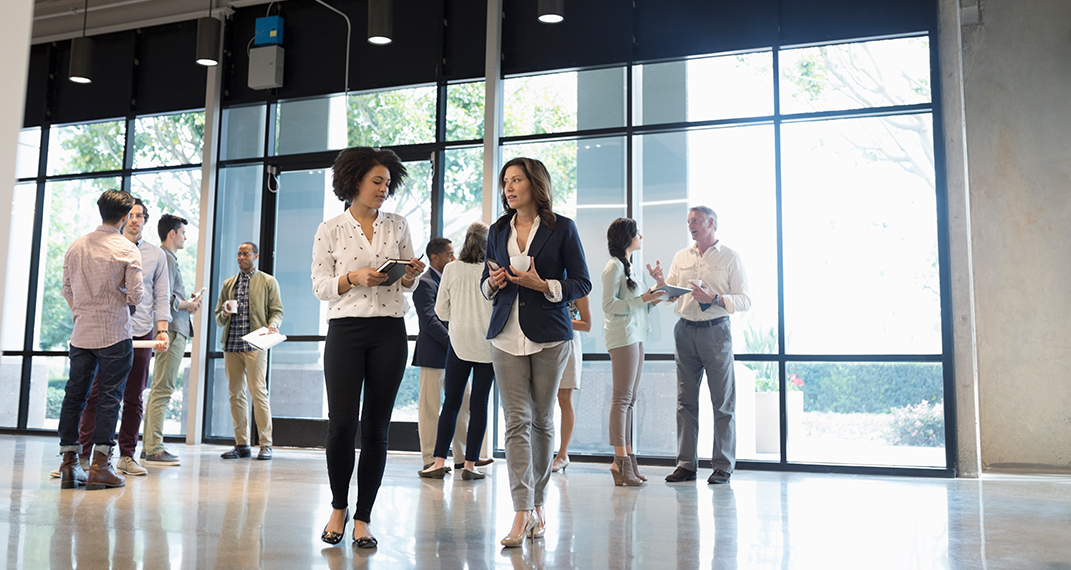Planning an event also means thinking about the comfort of your guests, where temperature and indoor air quality in the different spaces are key.
Planning an event requires great attention to detail in order to provide an excellent experience for the attendees; its location, the space, the decor and layout, the catering, the staff, the event program itself… and, among others, how atmosphere influences comfort .
To ensure attendees’ comfort, one crucial element that may not always be foremost in the minds of event organizers is accessibility to reliable climate control technology. Since HVAC systems manage temperature requirements and provide ventilation, they are essential to the success of any indoor event. After all, you’ll know that indoor air quality (IAQ) factors such as temperature, humidity, and odor can influence your enjoyment and concentration during an event, especially when the occasion has attracted a large number of attendees.
For this article, we focus on purpose-built spaces that have facilities for hosting events, talks and even exhibitions, to understand what factors influence IAQ at an event and, consequently, the comfort of attendees and the guest experience.

Factors affecting the atmosphere of an event
We’ve talked previously about how air conditioning systems can help enhance the experience , whether it’s at a restaurant, hotel or shopping center, giving guests and customers the ideal atmosphere that benefits the business. The ambient temperature of a commercial space (the air temperature in a given environment) can vary depending on the weather, the number of occupants, the heat emitted by electrical equipment and other such sources.
Now stepping into an event space and adding to the points above, events have their own set of challenges that make their atmospheric needs unique at times. These are:
- Fluctuating temperatures.
The occupancy of a building affects the efficiency and effectiveness of an HVAC system. Our bodies naturally emit heat and the more occupants in a space, the more heat will build up inside. During an event, there is usually a constant flow of attendees moving from one space to another, which means that an area with speakers or main booths will more likely have a higher ambient temperature than other areas. But if there are multiple focal points at an event, it can lead to fluctuations in ambient temperature that will need to be adjusted. - Staging and large seating areas.
Staging usually attracts the most attention from attendees, especially when keynote speakers and presentations are taking place, gathering crowds of various sizes. These spaces are subject to moments of concentrated movement followed by people sitting and watching the programmed content. Comfort will need to be considered, taking into account those in the audience as well as those on stage, where another set of factors can influence the temperature, leading to the next factor to consider. - Lighting, screens and electrical equipment.
As a speaker on stage, if the light beats down it is likely to make you feel hot under the collar. Along with screens and other electrical equipment, the temperature will rise even higher, impacting those on stage and the audience. This is one of the main reasons why event spaces, theaters and concert halls are now using LED lighting, which is not only more energy efficient, but also produces much less heat. Of course, the stage isn’t the only space where electrical equipment will create heat, some booths are equipped with screens, lighting and other equipment that, combined with the heat emitted from other booths, can cause the mercury inside event spaces to rise. - On-site catering and cooking areas.
Depending on the location of the event catering service, it may be prepared outside and served only on-site, or if there is a dedicated cooking area inside the event space, the HVAC requirements will be different. Cooking creates fumes, odors and heat that, depending on the location in relation to attendees, must be quickly dissipated. If this is not managed effectively, IAQ becomes poor and the atmosphere is uncomfortable. - The challenges of closed indoor spaces.
In relation to the above point, even if there is no on-site cooking at the event, the indoor air needs to be treated. Although cooling and heating are easier to control in enclosed spaces, they also trap moisture and pollutants such as dust and gases. In event spaces where natural ventilation is not possible, their buildup becomes a problem if not taken into account, especially when CO₂ levels become too high causing ‘status air’. And the more people attending an indoor event means a higher concentration of CO2₂, which needs to be kept at safe levels for comfort and health.

Indoor Air Quality at Events Matters
We’ve discussed the unique factors of events when considering what HVAC criteria are needed, but why does indoor air quality matter at an event?
Beyond being unpleasant or causing fatigue, a build-up of ‘stale air’ can be harmful, triggering allergies, causing headaches and even nose and throat pain. This is the last thing you want.
There are a combination of factors that determine indoor air quality. Among other things, IAQ considers CO2 concentration, humidity, temperature and the presence of pollutants such as volatile organic compounds (VOCs).
- CO₂ concentration.
Briefly mentioned when talking about enclosed spaces, when levels start to rise too high, it can create a stuffy feeling, which leads to drowsiness and difficulty concentrating, and can also cause headaches and other respiratory-related discomforts. Fortunately, it’s easy to avoid this by regularly ventilating your space, either by opening windows and doors or through specialized ventilation and air renewal technology connected to your HVAC system. These dilute indoor air with fresh air and quickly improve the IAQ of the space. - Humidity.
Humidity in the air also affects our sense of comfort. ASHRAE recommends a maximum relative humidity of 60%, although a minimum of 30% should be respected to avoid an overly dry atmosphere that can irritate the skin and respiratory system. In extreme cases, excess humidity can not only feel uncomfortable, making us feel warmer, but can also lead to mold growth. Of course, high occupancy at events affects the relative humidity, so being able to monitor humidity levels to keep them at the proper range is a plus. HVAC systems are able to help keep levels low with features such as dry mode, found on Oneconcept HVAC equipment, eliminating excessive moisture from indoor spaces. - Pollutants.
VOCs (emitted by paints, carpets, cleaning products, etc.), allergens and other pollutants (including cooking vapors) can create unpleasant smells and even affect our health. During an event, perhaps the biggest culprit of these pollutants will be the materials used for stands and decorations and any catering. As well as controlling ventilation and humidity, an effective way to reduce the presence of indoor air pollutants is through air conditioning filters. PM2.5 filters can trap microscopic particles as small as 2.5 μm, and specialized filters help neutralize bacteria and viruses for safer air. - Temperature.
The ideal indoor temperature for commercial premises depends on the season and the type of activity carried out by the occupants. To complicate matters, thermal comfort, the “perfect” temperature that is neither too cold nor too warm, varies from person to person. Occupational Safety and Health Administration (OSHA) guidelines recommend setting the thermostat to an indoor temperature of 68-75°F (20-23.5 °C) in winter and 73-79°F (23-26 °C) in summer. The location, season and weather, as well as the insulation and architectural features of the building affect these recommendations, so finding the right temperature for your event will be a must.

